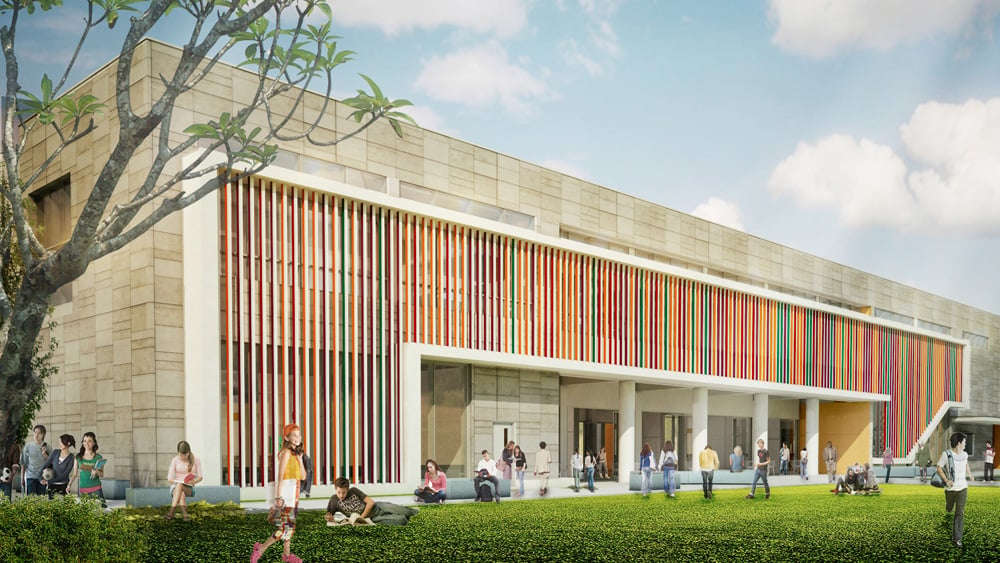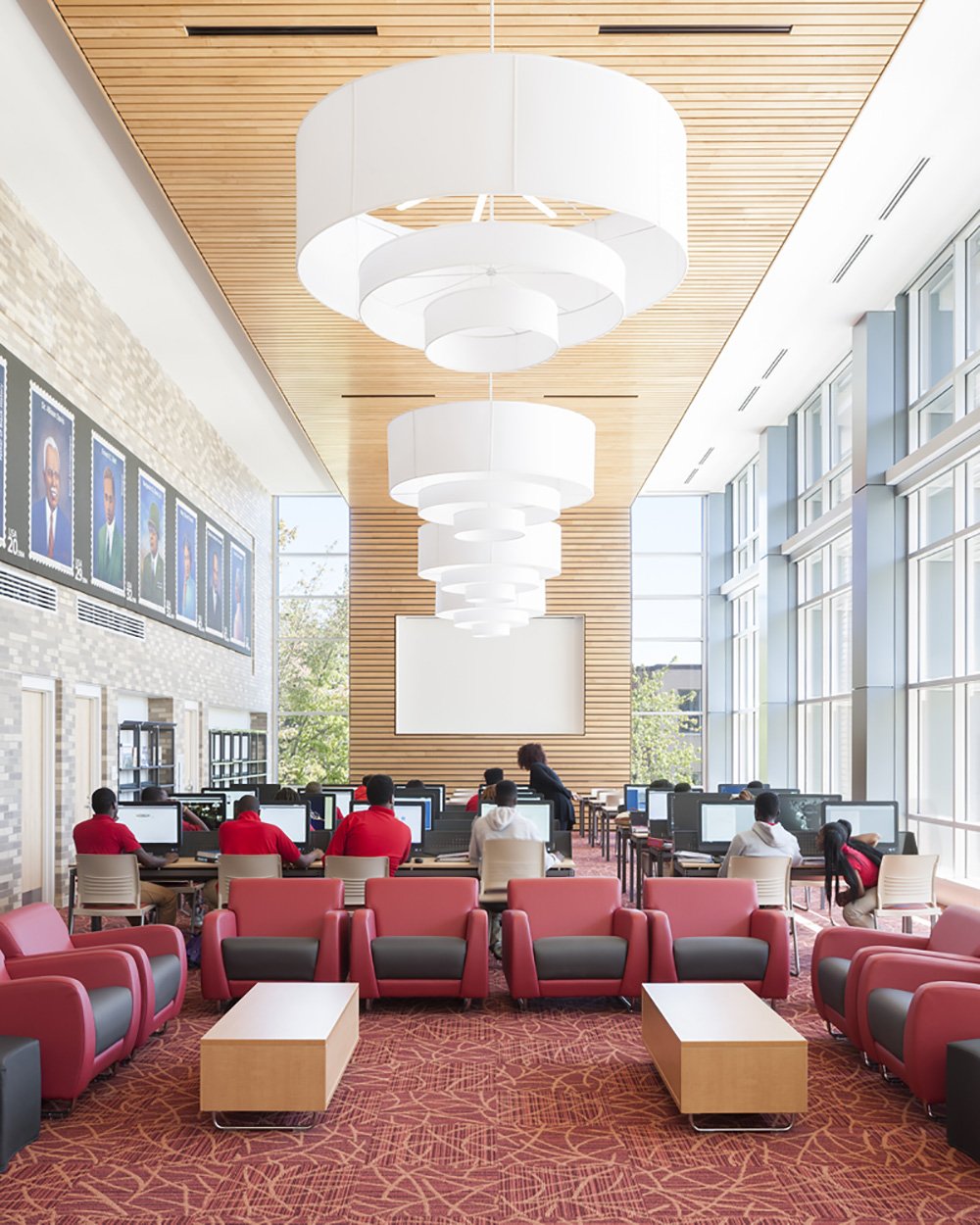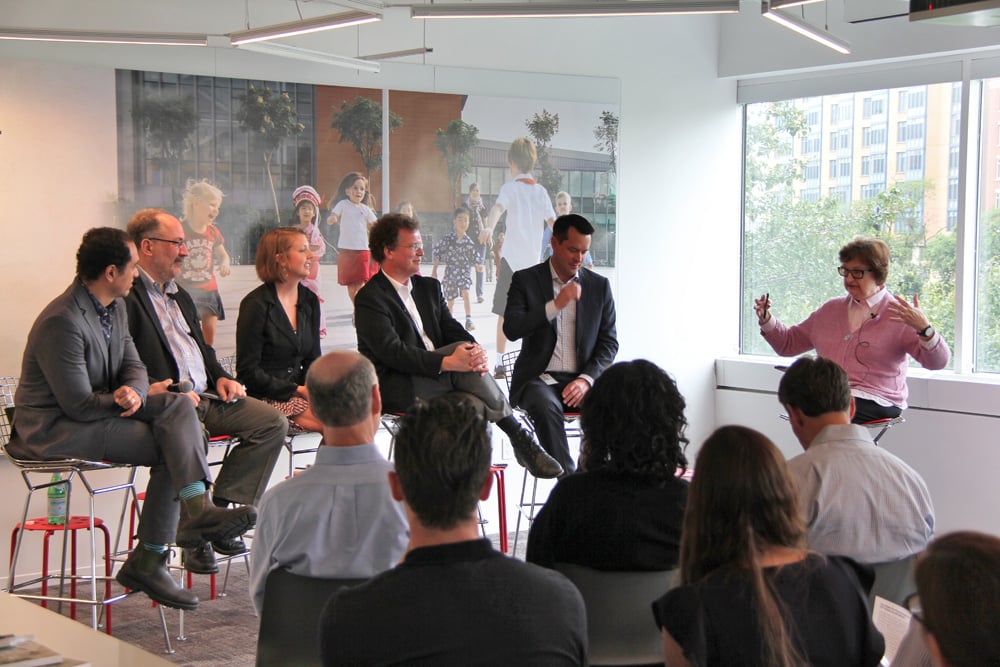
October 28, 2016
The High-Performance Learning Environment
Susan S. Szenasy talks with industry leaders at Perkins Eastman about their design for Dunbar Senior High School.

For the second year, Metropolis publisher and editor in chief Susan S. Szenasy has moderated a series of discussions with industry leaders on key issues surrounding human-centered design. On June 2, she talked with industry leaders at Perkins Eastman in Washington, DC. Together, they discussed DC’s Dunbar Senior High School and Colegio Franklin Delano Roosevelt, The American School of Lima, in Peru, to examine how local influences like culture, climate, and community influenced their design. The conversation was sponsored by DuPont Surfaces, Sunbrella, and Teknion. What follows is an edited transcript of the conversation, prepared by Dora Vanette.
The Urban Context
Susan S. Szenasy (SSS): Pedagogy has undergone some drastic changes in recent years—how we learn, what we need to learn—backed up by a growing awareness of environmental and health issues. In addition, massive urbanization is putting pressures on urban schools to be engaged with their communities.
Matthew J. Bell (MJB), FAIA, principal, Perkins Eastman: I’m an urbanist. I look at the context, the site, and the building from the outside in, and ask, “What can we do with this building so that the sum of the parts adds up to much more than just the building?” I’d like to think that our work at Dunbar High School is a good example of these ideas because of its appropriately honorific setting for entering an important building. I also think these schools are vital for our communities. And they have an obligation to not just teach the students who go there, but also engage the community in the ways people use the building, and the way in which the students inside see the city outside. Among the things schools have to do is to teach students to understand what it means to be responsible citizens in their future communities. Therefore schools need to be civic-looking and be recognized as place-makers.
We went through a generation of schools that were inwardly focused and ignored the social problems outside. Today, we have an obligation to help students understand that social problems are part of their education. In cities where real estate is at a premium, like Washington, DC, we need to build urban schools that work for the pedagogy they deliver and the sites that they sit on. I like to say that one of the main roles of architecture and urban design is to facilitate human interaction. Otherwise a school simply becomes a rental box.
SSS: Dunbar High School has a rich history. Let’s focus on what the school was, what it’s becoming, and the research that you did in order to understand the roots of the place and the building.
Sean O’Donnell (SO), AIA, LEED AP, principal and director, Perkins Eastman: Dunbar was the first African-American public high school in the country. The first building for the school was built in 1917 on this site. It was later demolished in 1977 and replaced by another building. We were challenged to demolish that building and build a third generation of buildings on the same site. In researching the school’s history, we found the incredibly rich story of the powerful learning community that was fostered by the original building. One thing that emerged from this research was what we learned about the armory, where they had events, dances, and ROTC training. In yearbooks, we found many entries like “I’ll never forget all our times in the armory.” So we wanted to provide a 21st-century interpretation of what that space could be, not remake the old armory. The 1977 building denied the history of the place; it ignored everything that came before. In contrast, we took on the school’s incredible heritage and embedded it into the architecture of the new building by creating a great central gathering space, like a town square.
We also wanted to embed the history into the building literally. There are now 200 plaques in the floor, 100 of which are engraved with the names, graduation dates, and major accomplishments of alumni. Dunbar’s ninth-graders were charged with researching former students and selecting the 100 out of the 600 or 700 people who merit being on one of those plaques. The idea was that as kids move through the building, they encounter their heritage and also see 100 blank plaques, where they, too, have a chance to be recognized for their own accomplishments.

SSS: It’s interesting to remember that the 1917 building was built at a time when the technology that gave us sealed spaces did not exist. In implementing new and sophisticated sustainability moves, how did you use the information that you found out about the original building?
Heather Jauregui (HJ), LEED AP BD+C, O+M, sustainability specialist, Perkins Eastman: Going back to passive design strategies that were prevalent in that era is what we’re trying to do now on all our projects. We’re reverting back to where we were. We’re relearning a great deal. Today’s research proves the value of having access to daylight and views in learning environments, as well as having good acoustics, and good indoor air quality.
SSS: Let’s talk about the big sustainability question and how the school relates to the urban context.
MJB: Sustainability begins with patterns of settlement. What we need to do is make existing places more livable. Making schools part of a more livable community is a bedrock of sustainability. The challenges are not just about renovating the schools and getting the proper performance out of them, but also looking at how schools contribute to the livability of the neighborhood. For instance, the 1977 building at Dunbar closed O Street. From the beginning we were adamant about opening up O Street because it is part of neighborhood connectivity; it is part of the experience of the whole campus. The street has also become important to the sustainable performance of the school, which now has bioretention, biofiltration areas. It’s a 21st-century street. It also offers a teachable moment for the students when their teachers tell them, “Look, here’s what this small move is doing with rainwater. It’s purifying it and it’s not contributing to the combined sewer and storm water outflow to the district.” It’s performing in a way that makes the neighborhood more connected, more sustainable.
SSS: It’s not common knowledge that such things happen in the biological world. How does that knowledge seep into the community?
MJB: My fantasy is that some ninth-grader takes an earth sciences class and goes out to look at O Street. Then when she comes home she says, “You know what I learned today? Go look at O Street because this is what it does.” The school can teach, and the kids can bring that knowledge into the broader community.
SSS: The building is LEED Platinum, the highest grade from the U.S. Green Building Council. Let’s talk about the specific sustainability moves that you recommended and achieved at Dunbar.
HJ: Pursuing LEED Platinum was a goal that we set forth from the start, but we like to think beyond LEED. We were concerned with creating a high-performance learning environment and equipping students to use design to move forward in their lives. So we oriented the classrooms along an east-west axis. They’re facing north and south, allowing us to control daylight really well. We minimize glare while maximizing the amount of natural light that enters the rooms. There are also geothermal wells as well as a PV [photovoltaic] array on the roof. But one of the greatest things about Dunbar is how it fits into the context and the walkability that it creates.

SSS: What’s the big energy picture here?
SO: Ultimately the task is to enhance educational outcomes. That’s why we prefer to talk about creating a high-performance learning environment. Sustainable design is a contributor to that. Our mission is to save energy, yes, but also to make the school a better place to learn. One metric we’re very proud of is that after the school occupied the new campus they achieved the highest test score gains of any high school in the city. That’s one example of the kinds of performance that we’re after. We want our graduates to be well prepared for life in the 21st century as well as be aware of the design and sustainability features that contribute to a better life. During construction, for instance, we hung banners on the site that called the attention of passersby to attributes of the building such as the geothermal wells, encouraging them to discover how they can help create a high-performance learning environment.
SSS: How do you tell students about geothermal and solar energy? How do they know that they’re in a building that’s powered by the earth and the sun? This is the kind of poetic statement that’s going to stay with them for a long time.
SO: We’ve integrated dashboards that actively track the building’s performance in real time. The energy performance in particular is widely available for analysis, both by the people operating the facility and the people using it. The same is true with the photovoltaic array. It’s easy for designers to say, “Here’s how we think this is going to work.” In reality, once operations begin, it’s the people in the building who need to get feedback in order to understand whether or not they’re achieving the established goals.
The Problem With Materials
SSS: There’s also a very interesting material story in the building.
HJ: Material health is a hot topic now. It’s a challenge because research shows that toxic chemicals within materials are affecting us. Obviously the school is an environment in particular where we don’t want our children exposed to toxins on a daily basis. We don’t want them ingesting these chemicals and carrying them for the rest of their lives. We all realize that challenge and we want to address it. But then we go to our product manufacturers and they won’t disclose information about what is in their products because it’s proprietary.
Currently, from a material health perspective, we’re in this difficult position where we don’t want to be specifying products that are bad, but we also don’t really know what’s in them. With version 4 of LEED, the design community is starting to push the envelope around material health. We’re asking for health product declarations from our manufacturers. This will force them to start giving us information that will help us make informed decisions.

Local Wisdom vs. International Style
SSS: How does a school like Dunbar and your other work in the United States translate to a school in Peru or in Africa? Is this translation even possible?
Omar Calderon (OC), AIA, principal, Perkins Eastman: In those other environments we don’t have access to as many of the advanced systems that Dunbar has. We have to rely on local wisdom on how buildings are sited. What is the building’s relationship to the sun? What is its relationship to prevailing winds? In Lima that’s exactly what we did. It became an exercise in learning the local wisdom of how buildings are sited in that part of the world and the patterns of use that exist in that country.
SSS: It’s an important moment. Local wisdom was forgotten in the 20th century when we built the same building everywhere. So what do you bring back from Colegio FDR, The American School of Lima, to Dunbar in DC and other schools located in very different climates?
OC: One is an understanding that important decisions about the design of a building happen very early on, at a large scale. We need to emphasize this.
Recently Sean and I were at a school where we heard complaints about how hot it was. We soon discovered that all of the schools in the area are sited incorrectly for solar orientation and the classrooms get very hot—of course people feel like they need air-conditioning.
SSS: Let’s talk about the changing pedagogy. What do you have to contend with now that we’re not designing fixed-seated, nailed-down classrooms anymore?
Jeff Bonvechio (JB), deputy director, DC Department of General Services: The real challenge is how we design for the unknown. You don’t want to put the school district or the client in a position of having to redo a building every 10 or 15 years because it doesn’t meet the program. How do you think ahead without really knowing what’s ahead?
SO: Today there’s a different way of engaging with content; some of it is digitally mediated, some of it is delivered in an asynchronous manner so that children can work at their own pace, in their own time. Such ideas start to challenge some of our fundamental assumptions about what a school building is. We have to think about what kinds of things a school might have to accommodate in the next 50 or 60 years without a major reinvestment.
SSS: What is the physical environment’s goal in this new way of learning?
HJ: Not long ago we used to think that the best learning environment was a windowless box because it was the least distracting. Now we know that that was a bad idea. Now theories about how the built environment impacts learning need to be grounded in scientific research. Intuitively we know that access to daylight and views is great, but showing the impacts on students is really important.
We’re looking into our past designs and testing them from a qualitative perspective—submitting surveys, seeing how people are interacting with the spaces—and from a more quantitative perspective: measuring daylight levels, acoustic decibel ranges, and CO2 levels. Then we correlate all this data to see if we are creating the high-performance environments that we set out to create.





